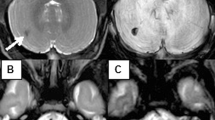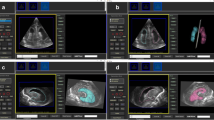Abstract
The objective of the study is to determine perinatal and postnatal factors that may affect the occurrence of small cerebellar hemorrhage (CBH) and to evaluate the effect of small CBH on neurodevelopmental outcome in very preterm infants. This prospective study in an unselected cohort of very preterm infants was approved by the medical ethics committee, and informed parental consent was obtained. Presence of small CBH (<4 mm) was assessed with magnetic resonance imaging around term equivalent age in 108 preterm infants (<32 weeks gestation). We compared infants with and without small CBH for perinatal and postnatal factors, supratentorial brain injury, and for neurodevelopmental outcome at 2 years corrected age. Follow-up consisted of a neurological examination, mental and developmental assessment (Bayley Scales of Infant Development), and behavior checklist. Univariate and multivariate logistic regression analyses were performed to examine the relationships between variables. Small CBH was diagnosed in 16/108 very preterm infants. Univariate analyses identified gestational age, high-frequency oscillation (HFO) ventilation, and grade 3–4 intraventricular hemorrhage (IVH) as factors associated with small CBH. HFO ventilation and severe IVH were independent predictors of small CBH. We found no association between small CBH and neurodevelopmental outcome at 2 years of age. Small CBH is a frequent finding in preterm infants. These hemorrhages are independently associated with HFO ventilation and severe supratentorial hemorrhage and seem to have a favorable short-term prognosis.

Similar content being viewed by others
References
Limperopoulos C, Benson CB, Bassan H, Disalvo DN, Kinnamon DD, Moore M, et al. Cerebellar hemorrhage in the preterm infant: ultrasonographic findings and risk factors. Pediatrics. 2005;116(3):717–24.
Merrill JD, Piecuch RE, Fell SC, Barkovich AJ, Goldstein RB. A new pattern of cerebellar hemorrhages in preterm infants. Pediatrics. 1998;102(6):E62.
Dyet LE, Kennea N, Counsell SJ, Maalouf EF, Ajayi-Obe M, Duggan PJ, et al. Natural history of brain lesions in extremely preterm infants studied with serial magnetic resonance imaging from birth and neurodevelopmental assessment. Pediatrics. 2006;118(2):536–48.
Steggerda SJ, Leijser LM, Wiggers-de Bruine FT, van der Grond GJ, Walther FJ, van Wezel-Meijler G. Cerebellar injury in preterm infants: incidence and findings on US and MR images. Radiology. 2009;252(1):190–9.
Muller H, Beedgen B, Schenk JP, Troger J, Linderkamp O. Intracerebellar hemorrhage in premature infants: sonographic detection and outcome. J Perinat Med. 2007;35(1):67–70.
Tam EW, Rosenbluth G, Rogers EE, Ferriero DM, Glidden D, Goldstein RB, et al. Cerebellar hemorrhage on magnetic resonance imaging in preterm newborns associated with abnormal neurologic outcome. J Pediatr. 2011;158(2):245–50.
Sehgal A, El-Naggar W, Glanc P, Asztalos E. Risk factors and ultrasonographic profile of posterior fossa haemorrhages in preterm infants. J Paediatr Child Health. 2009;45(4):215–8.
Volpe JJ. Cerebellum of the premature infant: rapidly developing, vulnerable, clinically important. J Child Neurol. 2009;24(9):1085–104.
Limperopoulos C, Soul JS, Gauvreau K, Huppi PS, Warfield SK, Bassan H, et al. Late gestation cerebellar growth is rapid and impeded by premature birth. Pediatrics. 2005;115(3):688–95.
Zayek MM, Benjamin JT, Maertens P, Trimm RF, Lal CV, Eyal FG. Cerebellar hemorrhage: a major morbidity in extremely preterm infants. J Perinatol. 2012;32(9):699–704.
McCarthy LK, Donoghue V, Murphy JF. Ultrasonically detectable cerebellar haemorrhage in preterm infants. Arch Dis Child Fetal Neonatal Ed. 2011;9(4):F281–5.
Limperopoulos C, Bassan H, Gauvreau K, Robertson Jr RL, Sullivan NR, Benson CB, et al. Does cerebellar injury in premature infants contribute to the high prevalence of long-term cognitive, learning, and behavioral disability in survivors? Pediatrics. 2007;120(3):584–93.
Grunnet ML, Shields WD. Cerebellar hemorrhage in the premature infant. J Pediatr. 1976;88(4 Pt. 1):605–8.
Leijser LM, de Bruine FT, Steggerda SJ, van der Grond GJ, Walther FJ, van Wezel-Meijler G. Brain imaging findings in very preterm infants throughout the neonatal period: part I. Incidences and evolution of lesions, comparison between ultrasound and MRI. Early Hum Dev. 2009;85(2):101–9.
de Bruine FT, van den Berg-Huysmans AA, Leijser LM, Rijken M, Steggerda SJ, van der Grond GJ, et al. Clinical implications of MR imaging findings in the white matter in very preterm infants: a 2-year follow-up study. Radiology. 2011;261(3):899–906.
Leijser LM, de Bruine FT, van der Grond GJ, Steggerda SJ, Walther FJ, van Wezel-Meijler G. Is sequential cranial ultrasound reliable for detection of white matter injury in very preterm infants? Neuroradiology. 2010;52(5):397–406.
Volpe JJ. Intraventricular hemorrhage in the premature infant—current concepts. Part II. Ann Neurol. 1989;25(2):109–16.
van Wezel-Meijler G, Leijser LM, de Bruine FT, Steggerda SJ, van der Grond GJ, Walther FJ. Magnetic resonance imaging of the brain in newborn infants: practical aspects. Early Hum Dev. 2009;85(2):85–92.
Messerschmidt A, Prayer D, Brugger PC, Boltshauser E, Zoder G, Sterniste W, et al. Preterm birth and disruptive cerebellar development: assessment of perinatal risk factors. Eur J Paediatr Neurol. 2008;12(6):455–60.
Bell MJ, Ternberg JL, Feigin RD, Keating JP, Marshall R, Barton L, et al. Neonatal necrotizing enterocolitis. Therapeutic decisions based upon clinical staging. Ann Surg. 1978;187(1):1–7.
Bancalari E, Claure N. Definitions and diagnostic criteria for bronchopulmonary dysplasia. Semin Perinatol. 2006;30(4):164–70.
Hadders-Algra M, Mavinkurve-Groothuis AM, Groen SE, Stremmelaar EF, Martijn A, Butcher PR. Quality of general movements and the development of minor neurological dysfunction at toddler and school age. Clin Rehabil. 2004;18(3):287–99.
Hempel MS. The Neurological Examination for Toddler-Age. 1st ed. The Netherlands: Groningen, University of Groningen; 1993.
Palisano RJ, Hanna SE, Rosenbaum PL, Russell DJ, Walter SD, Wood EP, et al. Validation of a model of gross motor function for children with cerebral palsy. Phys Ther. 2000;80(10):974–85.
Bayley, N. Bayley Scales of Infant and Toddler Development. 3rd edition. San Antonio, TX: Psychological Corp; 2006.
Achenbach TM, Ruffle TM. The Child Behavior Checklist and related forms for assessing behavioral/emotional problems and competencies. Pediatr Rev. 2000;21(8):265–71.
Achenbach TM, Rescorla LA. Manual for the ASEBA Preschool Forms and Profiles. Burlington, VT: University of Vermont, Research Center for Children, Youth, and Families; 2000.
Volpe. Neurology of the Newborn, vol. 10. Fifthth ed. Philadelphia: Saunders; 2008. p. 495–501.
Bassan H. Intracranial hemorrhage in the preterm infant: understanding it, preventing it. Clin Perinatol. 2009;36(4):737–62, v.
Donat JF, Okazaki H, Kleinberg F. Cerebellar hemorrhages in newborn infants. Am J Dis Child. 1979;133(4):441.
Messerschmidt A, Fuiko R, Prayer D, Brugger PC, Boltshauser E, Zoder G, et al. Disrupted cerebellar development in preterm infants is associated with impaired neurodevelopmental outcome. Eur J Pediatr. 2008;167(10):1141–7.
van Kooij BJ, Benders MJ, Anbeek P, van Haastert I, de Vries LS, Groenendaal F. Cerebellar volume and proton magnetic resonance spectroscopy at term, and neurodevelopment at 2 years of age in preterm infants. Dev Med Child Neurol. 2012;54(3):260–6.
Acknowledgments
We thank A. van Steenis and A. Jansen for collecting the perinatal data.
Funding Source
Financial activities related to the present article: Lara M. Leijser received a grant (no 920-03-388) from ZonMw, The Netherlands Organization for Health Research and Development.
Financial Disclosure Statement
The authors have no financial relationships to disclose which are relevant to this article.
Conflicts of Interest Statement
The authors have no conflicts of interest to disclose.
Clinical Trial Registry
This study was part of a research project on brain injury in very preterm infants registered in the Dutch trial register: http://www.trialregister.nl/trialreg/admin/rctview.asp?TC=676.
Author information
Authors and Affiliations
Corresponding author
Rights and permissions
About this article
Cite this article
Steggerda, S.J., De Bruïne, F.T., van den Berg-Huysmans, A.A. et al. Small Cerebellar Hemorrhage in Preterm Infants: Perinatal and Postnatal Factors and Outcome. Cerebellum 12, 794–801 (2013). https://doi.org/10.1007/s12311-013-0487-6
Published:
Issue Date:
DOI: https://doi.org/10.1007/s12311-013-0487-6




